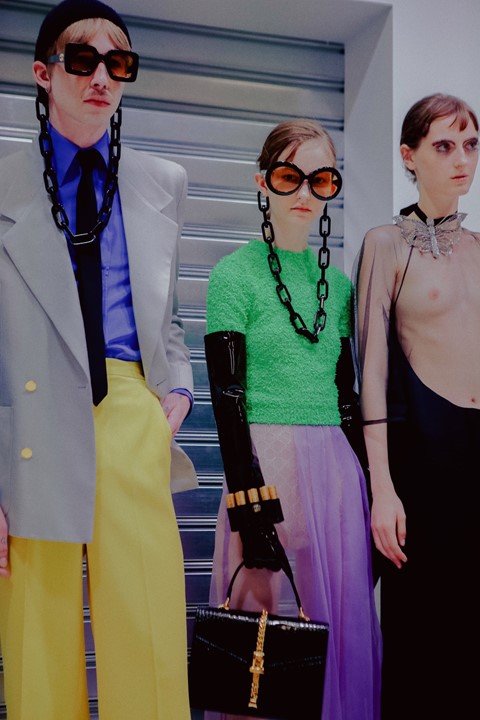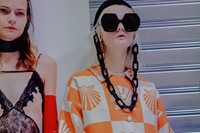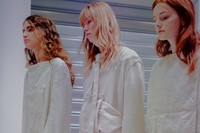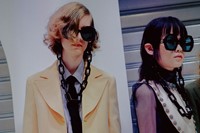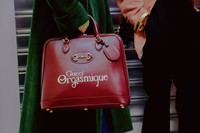Gucci’s Spring/Summer 2020 collection saw Alessandro Michele debut a new, streamlined vision
A stark white showspace, reminiscent of an operating theatre or perhaps the interior of a Stanley Kubrick-designed spacecraft, provided the backdrop for Alessandro Michele’s Spring/Summer 2020 show for Gucci, held yesterday afternoon in Milan. In lieu of a runway were four travelators – like those found in airports – which whirred to life as the show began.
The first models stood motionless, as if on a conveyor belt. Each wore an all-white look, institutional in design, like those of hospital patients or incarcerated prisoners. Some had buckles on the wrist, chest or back, like straitjackets. One after the other, more came. It was an image of restraint: of “uniforms, utilitarian clothes, the normative dress dictated by society and those who control it,” the house would later write on Instagram.
Earlier this month, Gucci announced that it had become an entirely carbon-neutral company – yesterday marked the first carbon-neutral show by the house – their efforts outlined in four words: avoid, offset, restore, reduce. This, for the monolithic Gucci, which has outposts and customers the world over, is an effort defined by restraint and restriction. Was this latest show from Alessandro Michele, for whom excess has been the defining characteristic of his hugely successful stint at the house, following suit? Was this Michele’s swerve towards reductionism?
Not quite. Mid-way through, the lights dimmed to black; the sound of static and exploding lightbulbs followed. Then, out marched the collection proper, bearing the recognisable hallmarks of Michele’s previous work – the giant sunglasses, the sequins, the offbeat accessories, the 1970s-inflected tailoring. This two-act structure, Michele elaborated, was supposed to depict the before-and-after of escape – from subjugation, from society, and the norms on which it’s organised, and on towards freedom. “Fashion in any expression is an escape to freedom,” he said after the show. As if to demonstrate the point, the first look of this second act was a black gown, sheer tulle to the navel, entirely exposing the model’s bare chest beneath. It was no straitjacket.
But this was not simply Michele treading old ground. “There were fewer things, so to speak,” Michele said backstage. “But can you say that a symphony is better than a piano solo?” This was a streamlined offering from the maximalist designer: where once Michele would have layered several garments and accessories in a single look, here they were often left to speak for themselves. Like the series of elegant, unembellished gowns, with petal-shaped cut-outs on the decolletage, in an array of simple block colours. “The collection is a little bit less than more,” said Michele.

The designer offered Tom Ford, a predecessor at the house, as an explanation of sorts – Michele said Ford’s work while at Gucci had a “strange elegance”. “The way Tom looked at sex was ambiguous,” he told Tim Blanks at Business of Fashion. “It was like he was destroying the family in a radical way. It was more like something pagan, and I was drawn to that perversity.” So there were cut-to-the-navel necklines and lace slip dresses, fastened with miniscule buckles; patent-leather opera gloves, riding crops and – in a surefire nod to Ford – strappy double-G monogrammed underwear, glimpsed through sheer organza dresses.
It made for perhaps Michele’s most alluring – and focused – collection yet. Backstage, he likened the beginning of the show to wiping the slate clean – then, he could begin to tread new ground. “I’m afraid of getting bored,” the designer said after the show. “I always have to try something new.”
